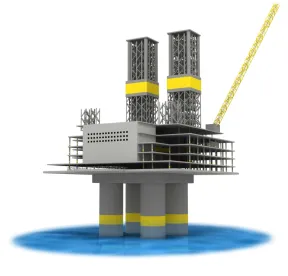Using carbon dioxide to produce oil could be a key technology to transition to an energy landscape with lower greenhouse gas emissions.
Injecting CO2 into an oil formation to produce oil is known as enhanced oil recovery (EOR). The injected CO2 not only increases pressure in the formation, which aids production, but under certain conditions, the CO2 will mix with oil trapped within the rock in the formation, causing it to become mobile and able to be produced.
EOR accounts for about four percent of US oil production. The process is an American invention, the first CO2 injection for oil production, known as a CO2 “flood,” being in West Texas in 1972.
Generally, much more CO2 needs to be injected into the subsurface to produce a barrel of oil than is emitted to the atmosphere from the combustion of that oil and its fractions. Today, most of the CO2 used for EOR – about 70% – is naturally-occurring CO2 released from the ground for the purpose of reinjection into an oil formation. A well is drilled for CO2 production, much as an oil well would be drilled. The naturally-occurring CO2 is released into a pipeline network for industrial use. If an EOR operation instead was able to use captured CO2 from industrial sources exclusively, it would raise the possibility of carbon negative oil.
An industry estimate shows that about 25% more CO2 is stored underground in an EOR operation than is emitted to the atmosphere as a result of the oil that is produced. This estimate accounts for all emissions associated with oil production and uses under all GHG Protocol categories – Scope 1 (direct development and operations), Scope 2 (indirect emissions, utility emissions, and electricity), and Scope 3 (transportation, refining, and combustion of the product). Other estimates range from slightly carbon positive to as much as 30% carbon negative. The actual number for any given oil field will differ, based on site-specific geology and operational efficiency.
A 2019 analysis by the Clean Air Task Force based on data from the International Energy Agency (IEA) found that EOR operations result in a 37% reduction in carbon emissions per barrel of oil than conventional oil production. This analysis is based on the use of a smaller amount of CO2 per barrel of oil produced than the industry reports using. It also accounts for factors that are speculative, such as increase in oil consumption as a result of oil being produced through EOR, which theoretically may lower oil prices.
These numbers would differ based on where the conventional oil is produced to which the EOR oil is being compared. Carbon emission intensity of oil production varies significantly by country. For example, production of oil in Venezuela results in almost twice the carbon emissions on average as production of oil in the United States. Oil production in Iran is roughly 50% more carbon intensive than US production.
Regardless of whether EOR stores more or less carbon dioxide than is emitted from the oil it produces, the point remains that it is significantly less emitting than conventional production.
Major energy consumption forecasting entities predict that global oil demand will continue to rise for at least the next decade and that heavy world oil demand will continue for many decades to come. In light of this, and in light of global interest in reducing carbon dioxide emissions, a question is what policies exist to encourage lower-emitting oil production, specifically EOR.
The main federal incentive to encourage EOR is the Section 45Q tax credit (named for its section within the federal tax code). Enacted in 2008, and significantly amended in 2018, the Section 45Q credit provides a per-ton credit for anthropogenic CO2 that is securely geologically stored, or is utilized in products (such as cement or aggregate) to prevent it from being released to the atmosphere. Under current law the credit will rise to $35/ton by 2027 for CO2 deployed for EOR, and to $50/ton by 2027 for CO2 sequestered in non-productive geologic formations, such as saline formations. Both prongs of the credit are adjusted for inflation in subsequent years. A carbon capture project must be “under construction” by 2026 in order to qualify for the credit.
EOR has been the economic driver for the construction of the roughly 5,000 mile CO2 pipeline network in the United States. As Congress works to encourage both kinds of CO2 storage – EOR and storage in saline and other non-resource bearing formations – it will need to consider the economic drivers that motivate building of the infrastructure that supports both.
The Biden Administration and Congress appear to be on different pages with respect to EOR. The Administration appears to be focused primarily on non-productive storage, among other things changing its nomenclature by referring to CCS, carbon capture and storage, instead of CCUS, carbon capture utilization and storage, the main “u” being EOR. However, bipartisan Members of Congress have introduced a slew of bills this year to enhance the Section 45Q tax credit in a variety of ways, by extending the credit, increasing the credit amounts, and making the credit refundable, among other things. House Democrats’ $3.5 trillion budget reconciliation bill includes provisions to extend the credit.
EOR attracted favorable attention this week in Congress, through questions to DOE Office of Fossil Energy Assistant Secretary nominee Brad Crabtree in the Senate Energy and Natural Resources Committee hearing on October 19, and in questions about its potential to produce carbon negative oil during the House Climate Committee hearing on October 20.
This key emissions mitigation and energy production tool, one in which the US has a significant advantage over the rest of the world, will need to continue to grow to continue progress toward meeting emission reduction targets.




 />i
/>i

